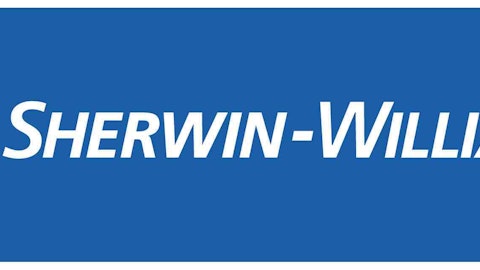As an investor, you will want to invest in companies that can provide the greatest return while preserving a margin of safety against competitors who threaten the bottom line of your business. Home improvement retailer The Home Depot, Inc. (NYSE:HD) commands a leadership presence in the sector and leaves competitors in the dust. Looking at the company from the perspective of strengths, weaknesses, opportunities, and threats will show you why this company belongs in your portfolio.
Strengths
Preparedness – As a business owner, you want your business to be in a position to take advantage of any opportunity that may come along. For example, according to Home Depot’s latest earnings call, some investments were made to make sure that the professional customer will get taken care of by improving speed and efficiency. This served as a catalyst for growth in the professional customer segment, exceeding the growth for the individual consumer this past quarter.
Moreover, The Home Depot, Inc. (NYSE:HD) even has a name for its approach called the “three-legged stool” which means it focuses on “customer service,” “product authority,” or knowledge, and “disciplined capital allocation and productivity and efficiency.” Home Depot’s explicit desire to reach the customer through multiple channels such as in store pick up, allowing PayPal payments, and acquisitions of companies that specialize in remodeling, demonstrates this company’s commitment to those principles.
In contrast, rival retailer Lowe’s Companies, Inc. (NYSE:LOW) remains bogged down in an inventory reset process that continues to disrupt its operations and serves as a drag on the company’s ability to take full advantage of the housing recovery. You may say that Lowe’s will eventually get its inventory up to snuff; however, while Lowe’s deals with this reset, Home Depot can focus on solidifying its leadership position unabated.
Ubiquity – In addition to preparedness, The Home Depot, Inc. (NYSE:HD) possesses greater ubiquity giving it greater purchasing power. Greater purchasing power translates into lower cost per unit allowing the company to profitably undercut its competition and/or boost margins.
As of the end of 2012, Home Depot operated 2,200 stores versus 1,745 for rival Lowe’s.
International presence – The Home Depot, Inc. (NYSE:HD) also possesses a greater presence outside of the United States giving it a jumpstart over Lowe’s Companies, Inc. (NYSE:LOW) in that arena. Home Depot operated 100 and 180 stores in Mexico and Canada respectively. Lowe’s, on the other hand, operated just 5 and 34 stores in Mexico and Canada respectively.
Fundamentals – Not surprisingly, all of Home Depot’s strengths add up to fundamental superiority over Lowe’s.
In its most recent quarter, The Home Depot, Inc. (NYSE:HD) experienced an increase in revenue and free cash flow of 7% a piece. Cash and investments represent 26% of Home Depot’s stockholder’s equity. It paid out 24% of its free cash flow in dividends. Home Depot currently sports a 2% dividend yield not bad for a business in a rebounding sector of the economy.
Lowe’s by contrast, experienced a revenue decline of 49 basis points. It’s free cash flow declined 17% in its most recent quarter. Cash and investments calculates to 11% of stockholder’s equity. Lowe’s only paid out 10% of its free cash flow in dividends. As of this writing, Lowe’s dividend yield calculates to 1.75%.
Lumber Liquidators Holdings Inc (NYSE:LL) a retailer specializing in hardwood flooring sported better fundamentals with revenue and free cash flow growing 23% and 18% respectively. Lumber Liquidator’s (NYSE:LL) cash to stockholder’s equity calculates to 29%. However, its 290 stores pale in comparison to Home Depot’s 2,300 stores.
Weaknesses
China – According to The Home Depot, Inc. (NYSE:HD)’s latest shareholder meeting, its CEO Frank Blake said his lack of focus on the Chinese customer caused the company to languish in the region resulting in its pullout from the region.
Seasonal exposure – In its most recent quarter, Home Depot experienced some negative comparable sales in its gardening line of products suggesting some of Home Depot’s sales depend on the timing of seasonal temperature changes.
Opportunities
Acquisitions – You can see other examples of The Home Depot, Inc. (NYSE:HD)’s focus on the customer through acquisitions of Measurecomp, a company that specializes in making complex measurements and US Home Systems Inc (NASDAQ:USHS) a company that helps you design cabinets and storage spaces.
These will go a long way in increasing consumer convenience when you need to make measurements for that complicated project and build or redesign kitchen and storage spaces with money made in this new economic recovery.
Threats
Competition – Lowe’s recently put in a “stalking horse” bid to purchase 60 stores of the now bankrupt Orchard Supply Hardware Stores Corp (NASDAQ:OSH). If successful, this will significantly boost its presence in the state of California, making it a more affective competitor against Home Depot there.
Moreover, Lowe’s may eventually roar into first place over the next few years once it gets past its inventory resets. Lowe’s intended purchase of Orchard Supply Hardware Stores Corp (NASDAQ:OSH) shows its desire to improve its strategic positioning.
The growth and increasing popularity of Lumber Liquidators Holdings Inc (NYSE:LL) will serve as a threat to Home Depot’s own flooring department. Lumber Liquidators focus on flooring will give it a specialized expertise in that area. You may argue that Home Depot’s big box format allows it to sell a greater variety and puts the company in a different league.
Housing reversal – In the chart below you can see that the housing recovery translated into market beating returns of 43%, 41%, and 130% for Home Depot, Lowe’s, and Lumber Liquidators respectively over the past year. P/E ratios of Home Depot and Lowe’s reside around 24 and 23 respectively. Lumber Liquidators P/E Ratio resides near an excessive 39 exceeding the S&P mean of 15. If housing sentiment was to suddenly reverse then the fundamentals of these companies would suffer and subsequently their stock price.
HD Total Return Price data by YCharts
Looking ahead
The Home Depot, Inc. (NYSE:HD)’s preparedness and focus on customer service will give the company an added boost during the housing recovery and solidify its position as a leader in home improvement retailing. As part owner of a business you will want it to reside in a comfortable position versus its competition. Home Depot definitely merits your research attention.
William Bias has no position in any stocks mentioned. The Motley Fool recommends Home Depot, Lowe’s, and Lumber Liquidators. The Motley Fool owns shares of Lumber Liquidators. William is a member of The Motley Fool Blog Network — entries represent the personal opinion of the blogger and are not formally edited.
The article Should You Invest in This Home Improvement Leader? originally appeared on Fool.com and is written by William Bias.
Copyright © 1995 – 2013 The Motley Fool, LLC. All rights reserved. The Motley Fool has a disclosure policy.







